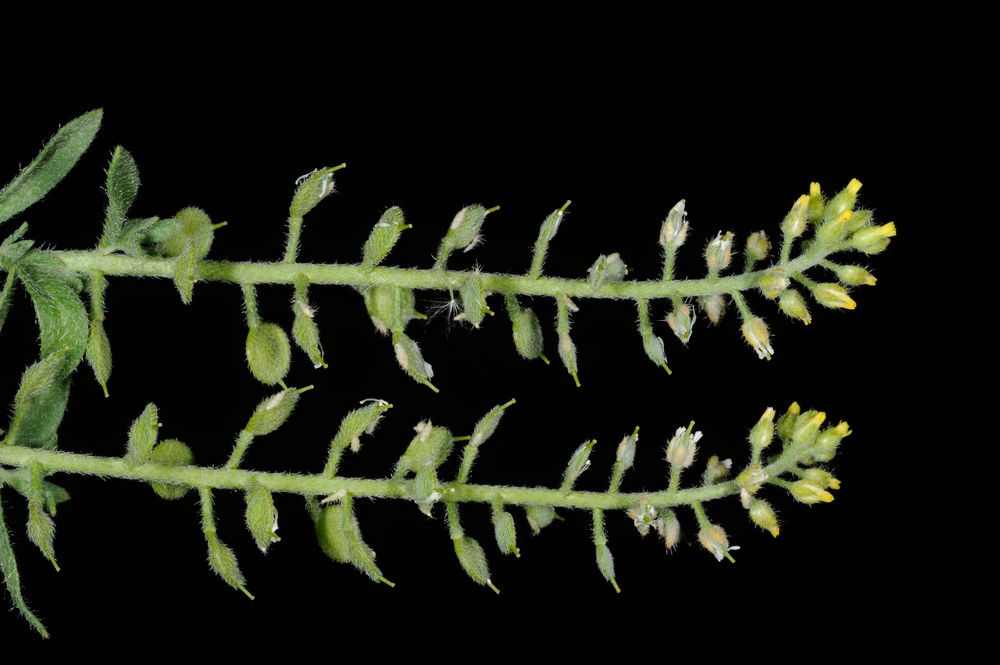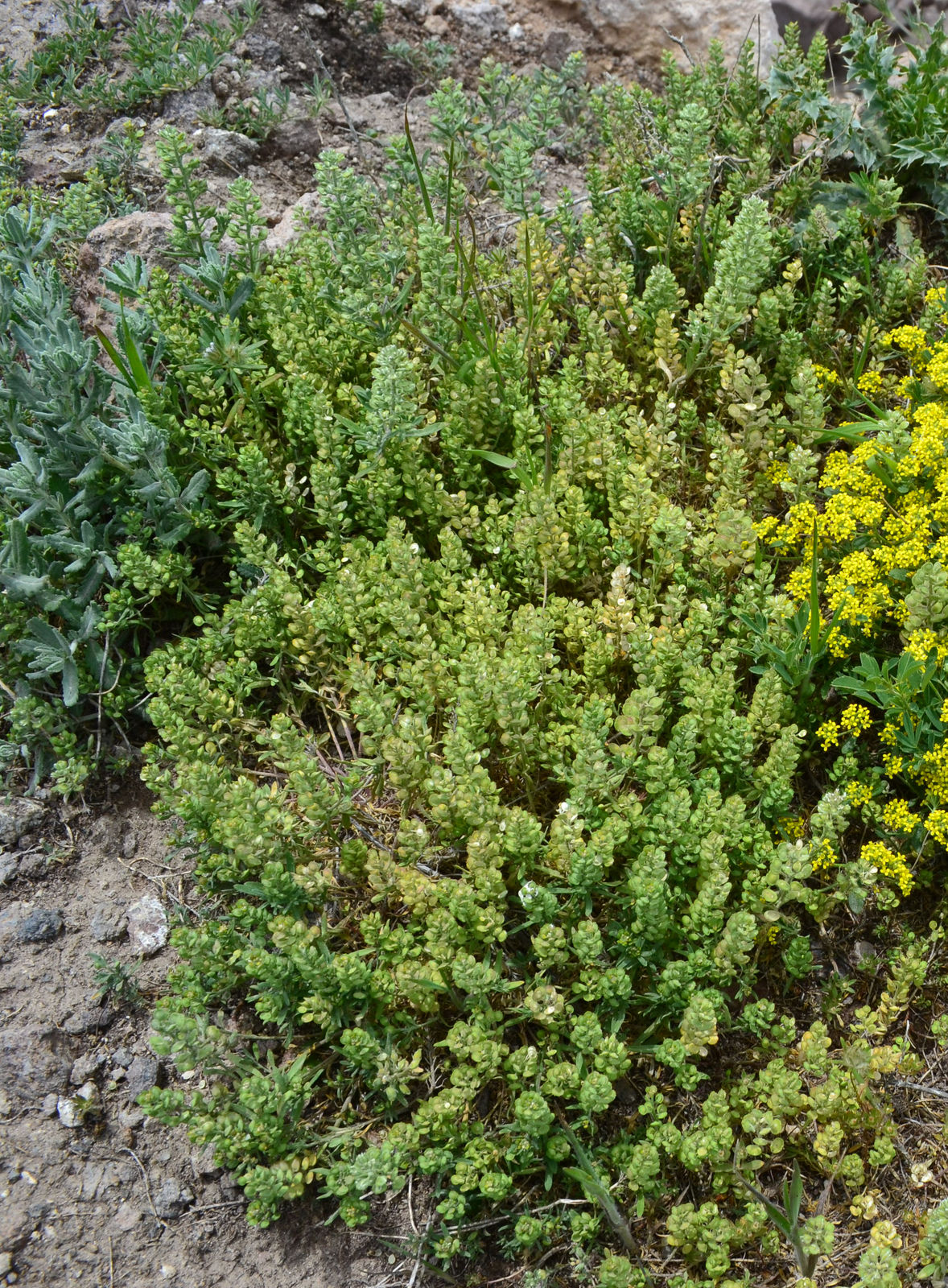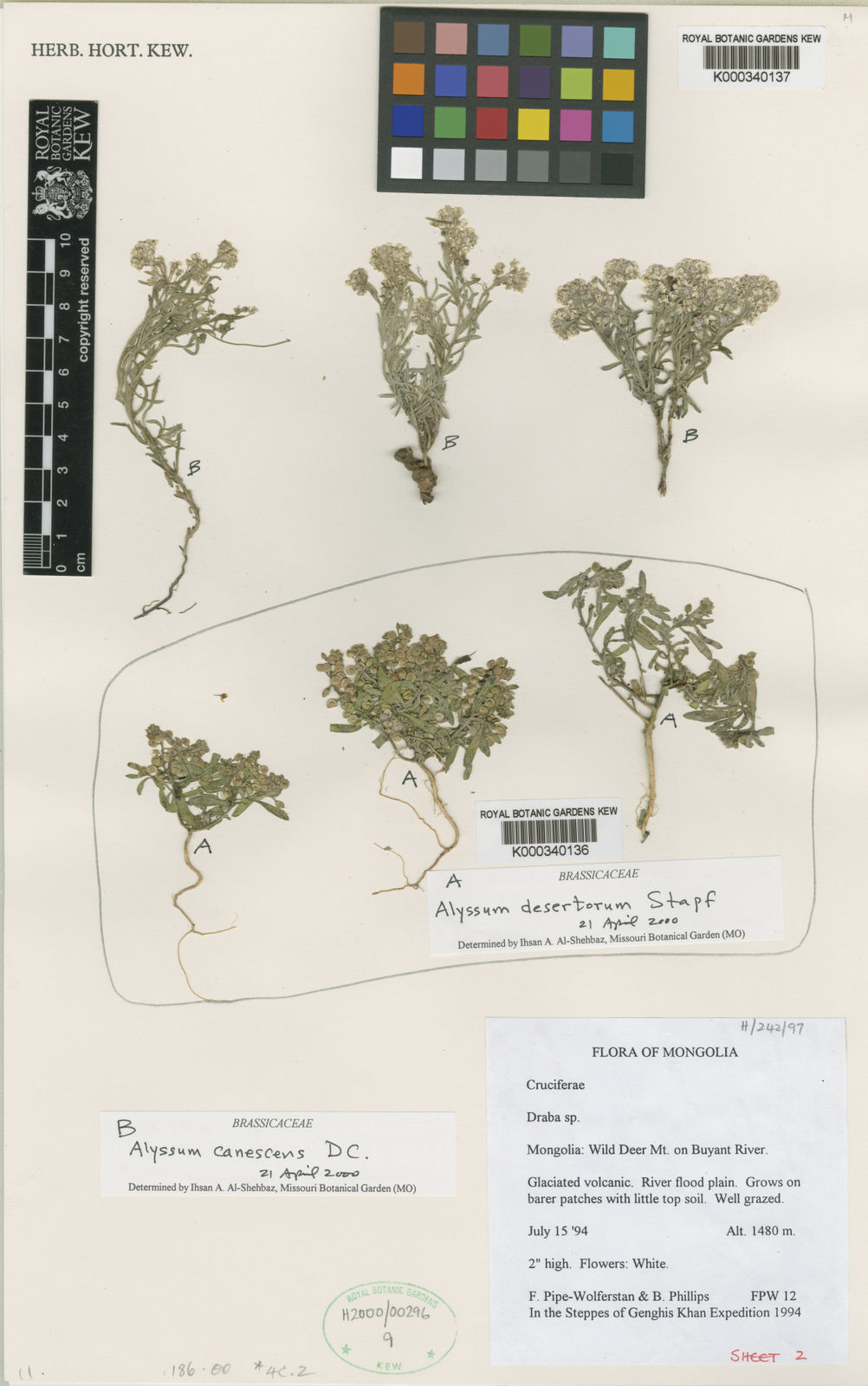Family: Brassicaceae
Author: Stapf
Bibliography: Denkschr. Kaiserl. Akad. Wiss., Wien. Math.-Naturwiss. Kl. 51: 33 (1886)
Year: 1886
Status: accepted
Rank: species
Genus: Alyssum
Vegetable: False
Observations: EC. & SC. Europe to Mongolia and W. Himalaya
Description
The Desert Madwort, scientifically known as Alyssum desertorum, is a resilient member of the Brassicaceae family, distinguished by its ability to thrive in some of the most challenging environments. Documented extensively by Stapf in Denkschriften der Kaiserlichen Akademie der Wissenschaften, Wien. Mathematisch-Naturwissenschaftliche Klasse in 1886, this hardy plant has garnered interest for its wide geographical distribution and unique adaptations.
Alyssum desertorum has a native range that extends across Eastern and Central Europe, reaching as far as Mongolia and the Western Himalayas. This vast distribution underscores the plant’s remarkable adaptability to diverse climatic and soil conditions. Typically found in arid and semi-arid regions, the Desert Madwort is well-suited to withstand extremes in temperature and prolonged periods of drought, making it a subject of study for those interested in desert flora and xerophytic plant species.
The plant itself is modest in appearance but profoundly significant ecologically. Desert Madwort often features small, clustered yellow flowers that bloom modestly yet contribute to the biodiversity of the harsh landscapes it inhabits. Its growth habit and root structure are adapted to maximize water uptake and minimize water loss, key traits that ensure its survival in environments where water is a scarce resource.
In addition to its ecological adaptations, Alyssum desertorum holds potential value in research on sustainable land management and agriculture in arid regions. Its resilience and low water requirements offer valuable insights into crop improvement strategies, particularly in areas suffering from desertification and water scarcity.
Overall, the Desert Madwort exemplifies the remarkable ways in which life adapts to some of the Earth’s most inhospitable terrains. Through continued study, plants like Alyssum desertorum not only deepen our understanding of ecological resilience but also provide crucial knowledge that could help mitigate the impacts of climate change on both natural ecosystems and human agriculture.
Common Names
En: Desert madwort
Zh: Ting ji
Da: Steppe-grådodder
Et: Liiv-kilbirohi
De: Steppen-Steinkraut
Lv: Tuksneša alise
Lt: Mažasis laibenis
Sv: Stäppdådra
Synonyms
- Alyssum desertorum f. argenteum (Beck)
- Alyssum desertorum var. socolacicum (Plazibat)
- Alyssum turkestanicum var. desertorum ((Stapf) Botsch.)
- Alyssum sartorii (Heldr. ex Maire & Petitm.)
- Alyssum desertorum var. himalayense (T.R.Dudley)
- Alyssum desertorum var. prostratum (T.R.Dudley)
Distribution
- Afghanistan (native)
- Albania (native)
- Austria (native)
- Belarus (native)
- Bulgaria (native)
- Central European Rus (native)
- Czechoslovakia (native)
- East European Russia (native)
- Egypt (native)
- Greece (native)
- Hungary (native)
- Iran (native)
- Iraq (native)
- Italy (native)
- Kazakhstan (native)
- Krasnoyarsk (native)
- Krym (native)
- Lebanon-Syria (native)
- Mongolia (native)
- North Caucasus (native)
- Pakistan (native)
- Palestine (native)
- Poland (native)
- Romania (native)
- Saudi Arabia (native)
- South European Russi (native)
- Tadzhikistan (native)
- Tibet (native)
- Transcaucasus (native)
- Turkey (native)
- Turkey-in-Europe (native)
- Turkmenistan (native)
- Tuva (native)
- Ukraine (native)
- Uzbekistan (native)
- West Himalaya (native)
- West Siberia (native)
- Xinjiang (native)
- Yugoslavia (native)
- Alberta (introduced)
- Baltic States (introduced)
- British Columbia (introduced)
- California (introduced)
- Colorado (introduced)
- Idaho (introduced)
- Montana (introduced)
- Nebraska (introduced)
- Nevada (introduced)
- New Mexico (introduced)
- North Dakota (introduced)
- North European Russi (introduced)
- Northwest European R (introduced)
- Oregon (introduced)
- Saskatchewan (introduced)
- South Dakota (introduced)
- Utah (introduced)
- Washington (introduced)
- Wyoming (introduced)
Additional Images

© copyright of the Board of Trustees of the Royal Botanic Gardens, Kew.

© copyright of the Board of Trustees of the Royal Botanic Gardens, Kew.

© copyright of the Board of Trustees of the Royal Botanic Gardens, Kew.
Flower
Taken Apr 24, 2022 by orish beliy (cc-by-sa)
Taken Apr 5, 2022 by Jennifer Carre (cc-by-sa)
Taken Apr 26, 2018 by Micheal Tuchband (cc-by-sa)
Taken May 7, 2021 by Sarah Jackson (cc-by-sa)
Fruit
Taken Apr 5, 2022 by Jennifer Carre (cc-by-sa)
Leaf
Taken Apr 5, 2022 by Jennifer Carre (cc-by-sa)
Habit
Taken Apr 7, 2016 by EOL − hannahharris (cc-by-nc)
Taken Apr 4, 2016 by EOL − g_phelan (cc-by-nc)
Taken Apr 4, 2016 by EOL − g_phelan (cc-by-nc)
Taken Feb 2, 2016 by EOL − Jim Bromberg (cc-by-nc)
Taken Apr 14, 2016 by EOL − hannahharris (cc-by-nc)
Sources
- WFO (No URL)
- IPNI (No URL)
- POWO (http://powo.science.kew.org/taxon/urn:lsid:ipni.org:names:277460-1)
- PlantNet (https://identify.plantnet.org/species/the-plant-list/Alyssum desertorum Stapf)
- GBIF (https://www.gbif.org/species/3044743)
Specifications
Growth habit>: Forb/herb











